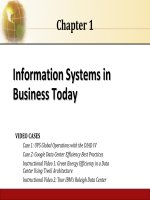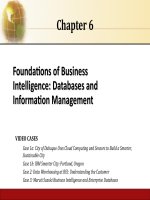Management information systems 13th laudon chapter 15
Bạn đang xem bản rút gọn của tài liệu. Xem và tải ngay bản đầy đủ của tài liệu tại đây (700.25 KB, 29 trang )
Chapter 15
Managing Global Systems
VIDEO CASES
Video Case 1: Daum Runs Oracle Apps on Linux
Video Case 2: Lean Manufacturing and Global ERP: Humanetics and Global Shop
Video Case 3: Monsanto Uses Cisco and Microsoft to Manage Globally
6.1
Copyright © 2014 Pearson Education, Inc. publishing as Prentice
Management Information Systems
Chapter 15: Managing Global Systems
Learning Objectives
• Describe the major factors driving the internationalization of
business.
• Describe the alternative strategies for developing global
businesses.
• Explain how information systems support different global
business strategies.
• Describe the challenges posed by global information systems
and management solutions for these challenges.
• Describe the issues and technical alternatives to be
considered when developing international information
systems.
15.2
Copyright © 2014 Pearson Education, Inc.
Management Information Systems
Chapter 15: Managing Global Systems
L’Oréal’s Global Makeover
• Problem: Large number of brands, products,
locations; complex production process; multiple
systems
• Solution: SAP’s ERP system implemented globally,
integrated with Apriso’s FlexNet for operations
management
• Demonstrates: The need for global firms to have
global systems for monitoring production
• Illustrates: The use of enterprise software to
enforce global quality and production standards
15.3
Copyright © 2014 Pearson Education, Inc.
Management Information Systems
Chapter 15: Managing Global Systems
The Growth of International Information Systems
• Global economic system and global world order
driven by advanced networks and information
systems
• Growth of international trade has radically altered
domestic economies around the globe
• For example, production of many high-end
electronic products parceled out to multiple
countries
– For example: Apple iPhone’s global supply chain
15.4
Copyright © 2014 Pearson Education, Inc.
Management Information Systems
Chapter 15: Managing Global Systems
APPLE IPHONE’S GLOBAL SUPPLY CHAIN
FIGURE 15-1
15.5
Apple designs the iPhone in the United States, and relies on suppliers in the United States, Germany,
Italy, France, and South Korea for other parts. Final assembly occurs in China.
Copyright © 2014 Pearson Education, Inc.
Management Information Systems
Chapter 15: Managing Global Systems
The Growth of International Information Systems
• Strategy when building international systems
– Understand global environment.
• Business drivers for global competition
• Inhibitors creating management challenges
– Develop corporate strategy for global competition.
– Develop organization structure and division of labor.
– Consider management issues.
• Design of business procedures, reengineering,
managing change
– Consider technology platform.
15.6
Copyright © 2014 Pearson Education, Inc.
Management Information Systems
Chapter 15: Managing Global Systems
INTERNATIONAL INFORMATION SYSTEMS ARCHITECTURE
The major dimensions for
developing an international
information systems
architecture are the global
environment, the corporate
global strategies, the structure
of the organization, the
management and business
processes, and the technology
platform.
FIGURE 15-2
15.7
Copyright © 2014 Pearson Education, Inc.
Management Information Systems
Chapter 15: Managing Global Systems
The Growth of International Information Systems
• Global business drivers:
– General cultural factors lead toward internationalization
and result in specific business globalization factors
15.8
GENERAL CULTURAL FACTORS
SPECIFIC BUSINESS FACTORS
Global communication and
transportation technologies
Development of global culture
Emergence of global social norms
Political stability
Global knowledge base
Global markets
Global production and operations
Global coordination
Global workforce
Global economies of scale
Copyright © 2014 Pearson Education, Inc.
Management Information Systems
Chapter 15: Managing Global Systems
The Growth of International Information Systems
• Challenges and obstacles to global business
systems
– General cultural challenges
• Cultural particularism
– Regionalism, nationalism, language differences
• Social expectations:
– Brand-name expectations, work hours
• Political laws
– Transborder data flow
– Transborder data and privacy laws, commercial
regulations
15.9
Copyright © 2014 Pearson Education, Inc.
Management Information Systems
Chapter 15: Managing Global Systems
The Growth of International Information Systems
• Challenges to global business systems (cont.)
– Specific challenges
• Standards
– Different EDI, e-mail, telecommunication standards
• Reliability
– Phone networks not uniformly reliable
• Speed
– Different data transfer speeds, many slower than United
States
• Personnel
– Shortages of skilled consultants
15.10
Copyright © 2014 Pearson Education, Inc.
Management Information Systems
Chapter 15: Managing Global Systems
The Growth of International Information Systems
• State of the art
– Most companies have inherited patchwork international
systems using 1960s-era batch-oriented reporting,
manual entry of data from one legacy system to another,
and little online control and communication
– Significant difficulties in building appropriate
international architectures
•
•
•
•
15.11
Planning a system appropriate to firm’s global strategy
Structuring organization of systems and business units
Solving implementation issues
Choosing right technical platform
Copyright © 2014 Pearson Education, Inc.
Management Information Systems
Chapter 15: Managing Global Systems
Organizing International Information Systems
• Global strategies and business organization
– Three main kinds of organizational structure
• Centralized: In the home country
• Decentralized/dispersed: To local foreign units
• Coordinated: All units participate as equals
– Four main global strategies
• Domestic exporter
• Multinational
• Franchisers
• Transnational
15.12
Copyright © 2014 Pearson Education, Inc.
Management Information Systems
Chapter 15: Managing Global Systems
Organizing International Information Systems
GLOBAL BUSINESS AND STRATEGY
BUSINESS
FUNCTION
DOMESTIC
EXPORTER
MULTINATIONAL
FRANCHISER
TRANSNATIONAL
Production
Centralized
Dispersed
Coordinated
Coordinated
Finance/
Accounting
Centralized
Centralized
Centralized
Coordinated
Sales/
Marketing
Mixed
Dispersed
Coordinated
Coordinated
Human
Resources
Centralized
Centralized
Coordinated
Coordinated
Strategic
Management
Centralized
Centralized
Centralized
Coordinated
15.13
Copyright © 2014 Pearson Education, Inc.
Management Information Systems
Chapter 15: Managing Global Systems
Organizing International Information Systems
• Global systems to fit the strategy
– Configuration, management, and development of
systems tend to follow global strategy chosen
– Four main types of systems configuration
1. Centralized: Systems development and operation occur
totally at domestic home base
2. Duplicated: Development occurs at home base but
operations are handed over to autonomous units in
foreign locations
3. Decentralized: Each foreign unit designs own solutions
and systems
4. Networked: Development and operations occur in
coordinated fashion across all units
15.14
Copyright © 2014 Pearson Education, Inc.
Management Information Systems
Chapter 15: Managing Global Systems
GLOBAL STRATEGY AND SYSTEMS CONFIGURATIONS
FIGURE 15-3
15.15
The large Xs show the dominant patterns, and the small Xs show the emerging patterns. For instance, domestic
exporters rely predominantly on centralized systems, but there is continual pressure and some development of
decentralized systems in local marketing regions.
Copyright © 2014 Pearson Education, Inc.
Management Information Systems
Chapter 15: Managing Global Systems
Organizing International Information Systems
• To develop a global company and
information systems support structure:
1.
Organize value-adding activities along lines of comparative
advantage.
• For example: Locate functions where they can best be performed,
for least cost and maximum impact.
1.
Develop and operate systems units at each level of corporate
activity—regional, national, and international.
2.
Establish at world headquarters:
• Single office responsible for development of international systems
• Global CIO position
15.16
Copyright © 2014 Pearson Education, Inc.
Management Information Systems
Chapter 15: Managing Global Systems
Managing Global Systems
• Principle management challenges in
developing global systems
–
–
–
–
–
15.17
Agreeing on common user requirements
Introducing changes in business processes
Coordinating application development
Coordinating software releases
Encouraging local users to support global systems
Copyright © 2014 Pearson Education, Inc.
Management Information Systems
Chapter 15: Managing Global Systems
Managing Global Systems
• Typical scenario: Disorganization on a global scale
– Traditional multinational consumer-goods company based in
United States and operating in Europe would like to expand
into Asia
– World headquarters and strategic management in United
States
• Only centrally coordinated system is financial controls and reporting
–
–
–
–
15.18
Separate regional, national production and marketing centers
Foreign divisions have separate IT systems
E-mail systems are incompatible
Each production facility uses different ERP system, different
hardware and database platforms, and so on
Copyright © 2014 Pearson Education, Inc.
Management Information Systems
Chapter 15: Managing Global Systems
Managing Global Systems
• Global systems strategy
– Share only core systems
• Core systems support functionality critical to firm
– Partially coordinate systems that share some key
elements
• Do not have to be totally common across national
boundaries
• Local variation desirable
– Peripheral systems
• Need to suit local requirements only
15.19
Copyright © 2014 Pearson Education, Inc.
Management Information Systems
Chapter 15: Managing Global Systems
LOCAL, REGIONAL, AND GLOBAL SYSTEMS
Agency and other coordination
costs increase as the firm
moves from local option
systems toward regional and
global systems. However,
transaction costs of
participating in global markets
probably decrease as firms
develop global systems. A
sensible strategy is to reduce
agency costs by developing
only a few core global systems
that are vital for global
operations, leaving other
systems in the hands of
regional and local units.
FIGURE 15-4
15.20
Copyright © 2014 Pearson Education, Inc.
Management Information Systems
Chapter 15: Managing Global Systems
Managing Global Systems
1. Define core business processes.
2. Identify core systems to coordinate centrally.
3. Choose an approach:
– Piecemeal and grand design approaches tend to fail.
– Evolve transnational applications incrementally from existing
applications.
1. Make benefits clear:
– Global flexibility
– Gains in efficiency
– Global markets and larger customer base unleash new economies of
scale at production facilities
– Optimizing corporate funds over much larger capital base
15.21
Copyright © 2014 Pearson Education, Inc.
Management Information Systems
Chapter 15: Managing Global Systems
Managing Global Systems
• The management solution: Implementation
– Agreeing on common user requirements
• Short list of core business processes
• Develop common language, understanding of common
elements and unique local qualities
– Introducing changes in business processes
• Success depends on legitimacy, authority, ability to
involve users in change design process
– Coordinating applications development
• Coordinate change through incremental steps
• Reduce set of transnational systems to bare minimum
15.22
Copyright © 2014 Pearson Education, Inc.
Management Information Systems
Chapter 15: Managing Global Systems
Managing Global Systems
• The management solution (cont.)
– Coordinating software releases
• Institute procedures to ensure all operating units
update at same time
– Encouraging local users to support global systems
• Cooptation: Bringing the opposition into design and
implementation process without giving up control over
direction and nature of the change
– Permit each country unit to develop one transnational
application
– Develop new transnational centers of excellence
15.23
Copyright © 2014 Pearson Education, Inc.
Management Information Systems
Chapter 15: Managing Global Systems
Interactive Session: Organizations
Hasbro Develops a Global Systems Strategy
Read the Interactive Session and discuss the following questions
• What problems was Hasbro having with its legacy SAP/R3
enterprise resource planning (ERP) system installed in the
1990s and how did it affect its operations and global strategy?
• What management, organization, and technology issues did
Hasbro address in order to implement a new global systems
strategy?
• Describe Hasbro’s new global systems and the problems they
solved. How did they improve operations and management
decision making?
15.24
Copyright © 2014 Pearson Education, Inc.
Management Information Systems
Chapter 15: Managing Global Systems
Technology Issues and Opportunities for Global Value Chains
• Technology challenges of global systems
– Computing platforms and systems integration
• How new core systems will fit in with existing suite of
applications developed around globe by different divisions
• Standardization: Data standards, interfaces, software, and
so on
– Connectivity
• Internet does not guarantee any level of service
• Many firms use private networks and VPNs
• Low penetration of PCs, outdated infrastructures in
developing countries
15.25
Copyright © 2014 Pearson Education, Inc.









